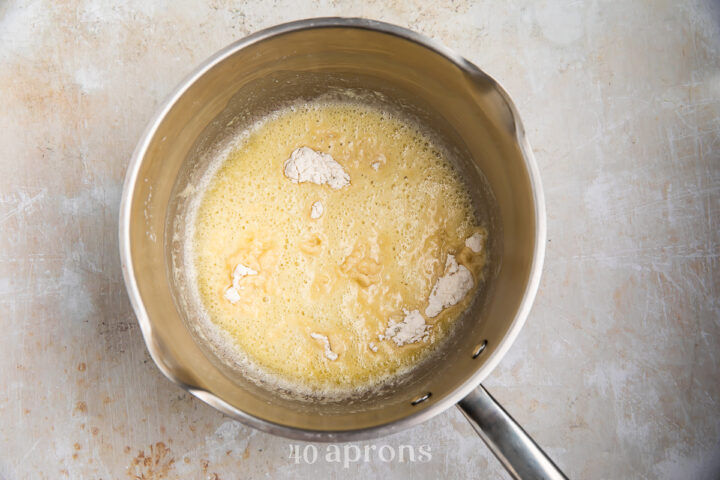
Gluten Free Gravy (With or Without Drippings)
40aprons.com/gluten-free-gravy/A gluten-free version of a traditional holiday side dish, this homemade gravy is savory, rich, and so easy to make.
Recipe Makes (Approximate): servings
Equipment
- medium saucepan
- whisk
Ingredients
- ¼ cup drippings (or butter)
- ¼ cup gluten-free all-purpose flour (see Notes)
- 2-3 cups low-sodium chicken stock (or beef stock, or a combination of both; see Notes)
- salt (to taste, see Notes)
- freshly cracked black pepper (to taste)
Instructions
- Heat medium saucepan over medium heat. When saucepan is warm, add drippings and heat through. Alternately, add butter to warm saucepan and let butter melt completely, swirling pan occasionally to coat bottom with butter.
- When drippings (or butter) are warmed through (or melted), sprinkle flour over top of liquid and whisk ingredients together vigorously until fully combined. Reduce heat to medium-low and simmer mixture, stirring occasionally, until mixture is golden but not burnt.

- Slowly pour in 1 cup of stock and whisk until mixture is smooth. Pour in another 1 cup stock and whisk again until ingredients are fully combined.
- Increase heat under saucepan to medium. Let mixture simmer, uncovered, 3 to 5 minutes or until mixture has thickened slightly. Add another ½ to 1 cup stock as needed to achieve desired consistency, whisking well to ensure all ingredients are fully combined. Note: amount of stock needed will vary depending on type of gluten-free flour used.
- When desired consistency is achieved, taste gravy and season with salt and pepper as needed. Serve warm.
Recipe Notes
- Flour: Any gluten-free flour will work here, but if you use one that contains xanthan gum, you may find that the flour clumps when it's added to the warm liquids. If it clumps, try whisking vigorously until the mixture smooths out. If that doesn't work, try blending the gravy with an immersion blender (or a regular blender) until the lumps are gone.
- Stock: I recommend low-sodium stock just so you don't end up with a gravy that's too salty. You can always add salt, but you can't take it away! Also, if you're new to gluten-free cooking, be sure you double-check that the stock you use actually is gluten free. Most are, but some brands sneak in gluten-containing ingredients.
- Salt: Use a gluten-free soy sauce in place of salt to give the gravy a deeper, richer color.
Nutrition Information (Approximate)
Serving Size: 1servingCalories: 89calProtein: 2gFat: 7gSaturated Fat: 3gTrans Fat: 0gCholesterol: 7mgSodium: 268mgPotassium: 80mgTotal Carbs: 4gFiber: 0.3gNet Carbs: 4gCalcium: 14mgIron: 0.4mg
https://40aprons.com/gluten-free-gravy/